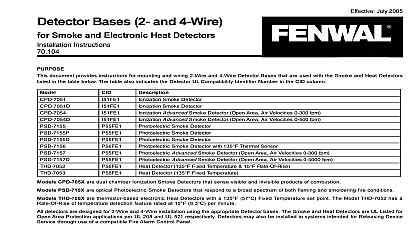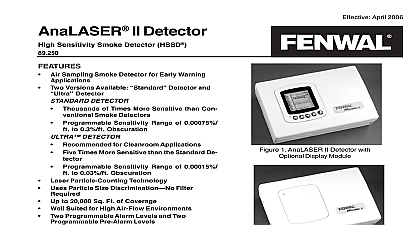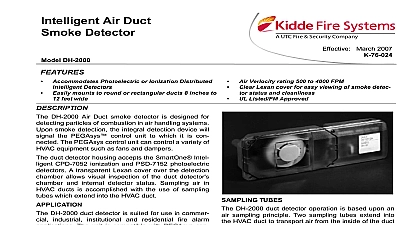Fenwal Detectafire 2012

File Preview
Click below to download for free
Click below to download for free
File Data
| Name | fenwal-detectafire-2012-2638401759.pdf |
|---|---|
| Type | |
| Size | 698.14 KB |
| Downloads |
Text Preview
DETECT A FIRE and Release Devices Repeatable resets itself nothing to replace Rugged withstands shock and vibration Versatile various temperature settings available Durable long lasting stainless steel shell Economical wide spacings reduce costs Factory set internal contact area is hermetically in stainless steel Protection of schools factories offices etc Power generation Gas station islands Paint spray booths Range hoods units are the heart of many Fire Systems These highly reliable devices have been standard of the industry for over 45 years Many thousands these units are now in use controlling the release of extin such as clean agents C02 water or dry chemicals some systems the device is used as an ALARM device to overheat or fire and alert personnel In other systems is used as a RELEASE device to sense fire and actuate attack systems units have met with wide acceptance they are designed with RATE COMPENSATION This a unique advantage over both fixed temperature rate of rise types of detectors because only the unit accurately senses the surrounding air regardless of the fire growth rate At precisely predetermined danger point the system is activated temperature detectors must be completely heated to temperature and therefore a disastrous lag in time may with a fast rate fire Rate of rise devices on the other are triggered by the rate of increase in ambient temper and are subject to false alarms caused by harmless thermal gradients such as the rush of warm air from ovens secret of the unit sensitivity is in the design Figure The outer shell is made of a rapidly expanding alloy which follows changes in surrounding air temperature The struts are made of a lower expanding alloy Designed to thermal energy absorption and sealed inside the shell struts follow temperature changes more slowly slow rate fire Figure 2 will heat the shell and struts At the set point the unit will trigger actuating the or releasing the extinguishant transient rush of warm air up to 40 F min may expand shell but not enough to trigger the unit By ignoring transient air excursions the DETECT A FIRE unit virtually false alarms prevalent with devices a fast rate fire Figure 3 starts the shell will expand The struts will close actuating the alarm or releasing agent The faster the fire rate of growth the sooner the unit will react 1 READY 2 SLOW FIRE 3 FAST FIRE Detection and Release Device 1 DETECT A FIRE UNITS DETECT A FIRE UNITS Mounting Unit Concealed Wiring Mounting Unit Exposed Wiring detectors are designed for locations where appearance a factor The attractive functional design lends physical of the unit while making it suitable for commercial mercantile and public buildings institutions and ships in locations those classified as ordinary under the Electric Code Flush mounted units are designed to fit 4 octagonal electrical boxes and surface mounting units designed to mount directly on ceilings or on 4 electrical junction Canadian Electrical Codes requires mounting only to an junction box DETECT A FIRE UNITS detectors are designed for use in both ordinary or locations For ordinary use they may be mounted any approved junction box with 7 8 diameter opening by using NPT mounting nuts The device may be wired in or out of depending on local preference and codes Four leadwires provided on normally open vertical units that close on temp rise per UL requirement to facilitate supervision of system Instruments are Underwriters Laboratory and Underwriters of Canada listed and Factory Mutual approved for locations when mounted in a suitable fitting units are not position sensitive Horizontal vertical detectors refer to the most common mounting for that unit However each type can be mounted horizontally or vertically depending on the application and requirements TYPE I Groups A B and D Class II E F and G I Groups B C D Class II E F and G REQUIRED UL ULC FM APPROVAL detector to a listed fitting accordance with Electric and or local having shown are distances between units on smooth ceilings the distances partitions or walls would be half that shown Authority having LOCAL jurisdiction be consulted before installation preset at factory only applications where corrosion is suspect care should be taken to protect DETECT A FIRE unit to realize optimum performance and maximum life factory for suggestions to 375 F 18 AWG Teflon insulated wire used on units 375 F 16 AWG TGGT insulated wire used on units UL521 requirements low temperature exposure test is 22 F 30 C subject to change without notice of Canada labeling available upon request incandescent lamps are considered resistive their inrush current is 10 15 times their current Do not exceed ratings NO ON UNIT ONLY F Max oz Amps 125 VAC Amps 125 VDC F Max oz Amps 125 VAC Amps 125 VDC Amps 24 VDC Amps 48 VDC steel shell sensing element Cold rolled steel facility Off White finish RATING setting a minimum of 100 F above ambient DETECT A FIRE MODELS Number 27020 27021 in feet White White White 27020 is a normally closed device and does not meet the of NFPA 72 for use as an initiating device 2 Detection and Release Device DETECT A FIRE UNITS DETECT A FIRE MODELS Head Number 27120 27121 in feet White White White Blue Red Red Green Orange Orange Orange Black Black White White White Blue Red Red Green Orange Orange Orange 27120 is a normally closed device and does not meet the of NFPA 72 for use as an initiating device Number 28020 28021 in feet For clean agents and CO2 supression systems ceiling spacing apart unless otherwise specified 28020 is a normally closed device and does not meet the of NFPA 72 for use as an initiating device DETECT A FIRE UNITS Head 3 Detection and Release Device


